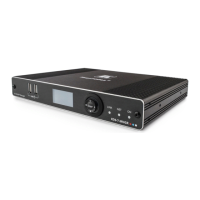KDS-7-MNGR – Protocol 3000
Set hostname.
+ The hostname is
not the same as the
model name. The
hostname is used to
identify a specific
machine or a
network in use (with
DNS feature on).
#NAME
<interface_id>,<host_name><CR>
~nn@NAME
<interface_id>,<host_name><C
R><LF>
<interface_id> -
0 - machine name
<host_name> - String of
up to 24 alpha-numeric
chars (can include
hyphen, underscore, not
at the beginning or end)
Set host name to MNGR1:
#NAME 0,MNGR1
#NAME? <interface_id><CR>
~nn@NAME
<interface_id>,<host_name><C
R><LF>
<interface_id> -
0 - machine name
<host_name> - String of
up to 24 alpha-numeric
chars (can include
hyphen, underscore, not
at the beginning or end)
Set a network
configuration.
+ Parameters
[DNS1] and
[DNS2]are optional.
+ For Backward
compatibility, the id
parameter can be
omitted. In this case,
the Network ID, by
default, is 0, which is
the Ethernet control
port.
+ If the gateway
address is not
compliant to the
subnet mask used
for the host IP, the
command will return
an error. Subnet and
gateway compliancy
specified by
RFC950.
#NET-CONFIG
<netw_id>,<net_ip>,<subnet_mask>,<g
ateway>,[dns1],[dns2]<CR>
~nn@NET-CONFIG
<netw_id>,<net_ip>,<subnet_ma
sk>,<gateway>,[dns1],[dns2]<C
R><LF>
<netw_id> - Network ID of
the device network
interface, counting is 0
based
<net_ip> - Network IP
<subnet_mask> - Subnet
mask
<gateway> - Gateway IP
address
[dns1] - (Optinal) DNS IP
address
[dns2] - (Optinal) DNS IP
address
Set the device network parameters to
IP address 192.168.1.100, net mask
255.255.255.0, and gateway
192.168.1.1:
#NET-CONFIG
0,192.168.1.100,255.255.255.0,192.1
68.1.1
Get a network
configuration.
#NET-CONFIG? <netw_id><CR>
~nn@NET-CONFIG
<netw_id>,<net_ip>,<subnet_ma
sk>,<gateway>,[dns1],[dns2]<C
R><LF>
<netw_id> - Network ID of
the device network
interface, counting is 0
based
<net_ip> - Network IP
<subnet_mask> - Subnet
mask
<gateway> - Gateway IP
address
[dns1] - (Optinal) DNS IP
address
[dns2] - (Optinal) DNS IP
address
Get network configuration:
#NET-CONFIG? 0
Set DHCP mode.
+ Only 1 is relevant
for the mode value.
To disable DHCP,
the user must
configure a static IP
address for the
device.
+ Connecting
Ethernet to devices
with DHCP may take
more time in some
networks.
+ To connect with a
randomly assigned
IP by DHCP, specify
the device DNS
name (if available)
using the NAME
command.
+ For proper settings
consult your network
administrator.
+ For Backward
compatibility, the id
parameter can be
omitted. In this case,
the Network ID, by
default, is 0, which is
the Ethernet control
port.
#NET-DHCP
<netw_id>,<dhcp_state><CR>
~nn@NET-DHCP
<netw_id>,<dhcp_state><CR><
LF>
<netw_id> - Network ID of
the device network
interface, counting is 0
based
<dhcp_state> -
1 - Try to use DHCP. (If
unavailable, use the IP
address set by the factory
or the net-ip command).
2 - Use static IP
settings
enable DHCP mode
#NET-DHCP 0,1
~nn@NET-DHCP
<netw_id>,<dhcp_state><CR><
LF>
<netw_id> - Network ID of
the device network
interface, counting is 0
based
<dhcp_state> -
1 - Try to use DHCP. (If
unavailable, use the IP
address set by the factory
or the net-ip command).
2 - Use static IP
settings
Get DHCP mode:
#NET-DHCP? 0
~nn@NET-IP
<ip_address><CR><LF>
<ip_address> - Network
IP
Get the IP address:
#NET-IP?

